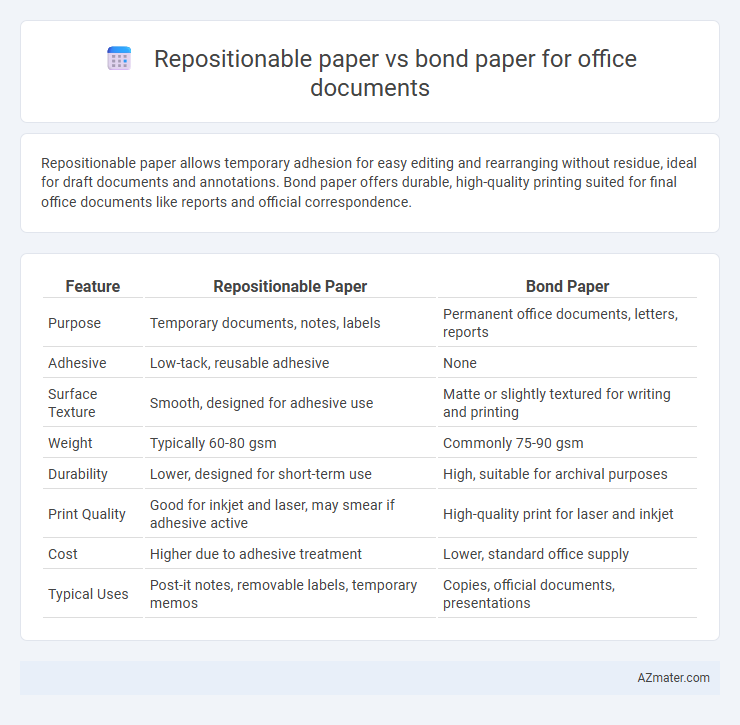Repositionable paper allows temporary adhesion for easy editing and rearranging without residue, ideal for draft documents and annotations. Bond paper offers durable, high-quality printing suited for final office documents like reports and official correspondence.
Table of Comparison
| Feature | Repositionable Paper | Bond Paper |
|---|---|---|
| Purpose | Temporary documents, notes, labels | Permanent office documents, letters, reports |
| Adhesive | Low-tack, reusable adhesive | None |
| Surface Texture | Smooth, designed for adhesive use | Matte or slightly textured for writing and printing |
| Weight | Typically 60-80 gsm | Commonly 75-90 gsm |
| Durability | Lower, designed for short-term use | High, suitable for archival purposes |
| Print Quality | Good for inkjet and laser, may smear if adhesive active | High-quality print for laser and inkjet |
| Cost | Higher due to adhesive treatment | Lower, standard office supply |
| Typical Uses | Post-it notes, removable labels, temporary memos | Copies, official documents, presentations |
Introduction to Office Document Paper Types
Repositional paper offers a temporary adhesive backing that allows easy repositioning of notes and documents without residue, making it ideal for drafts and annotations in office environments. Bond paper, characterized by its durability and smooth finish, is commonly used for official correspondence, reports, and high-quality printing due to its sturdy texture and professional appearance. Understanding the distinct properties of repositional and bond paper helps optimize office document handling and enhances workflow efficiency.
What is Repositional Paper?
Repositional paper is a type of adhesive sheet designed to stick and re-stick to surfaces without leaving residue, making it ideal for temporary notes or labels in office documents. Unlike bond paper, which is a standard non-adhesive writing paper used for printing and copying, repositional paper enhances organization by allowing easy repositioning and removal. This feature makes repositional paper particularly useful for annotations, reminders, and collaborative workflows in office settings.
What is Bond Paper?
Bond paper is a high-quality, durable paper commonly used for office documents, including letters, forms, and official reports. It features a smooth surface and is typically made from cotton fibers or wood pulp, providing strength and a professional appearance. Compared to repositionable paper, bond paper is designed for permanent use, making it ideal for printing, copying, and archival purposes.
Key Differences Between Repositional and Bond Paper
Repositional paper features a low-tack adhesive that allows sheets to be easily repositioned without damaging surfaces, ideal for temporary notes and planning in office environments. Bond paper, known for its durability and high brightness, is widely used for official documents, printing, and copying due to its smooth texture and strong fiber composition. The key difference lies in functionality: repositional paper offers adhesive flexibility for short-term use, whereas bond paper provides permanence and professional presentation for long-term document retention.
Print Quality Comparison
Repositional paper offers moderate print quality suitable for temporary labels and draft documents, featuring semi-gloss surfaces that enhance toner adhesion but may cause slight smudging with inkjet printers. Bond paper provides superior print clarity and sharpness due to its smooth, uncoated surface optimized for laser and inkjet printers, ensuring crisp text and vibrant graphics for professional office documents. High-resolution printing on bond paper reduces ink bleed and paper jams, making it the preferred choice for official reports, contracts, and archival-quality documents.
Durability and Longevity
Repositional paper features a low-tack adhesive backing, allowing sheets to be temporarily affixed and removed without damage, but this characteristic generally reduces its durability over time compared to bond paper. Bond paper, made from high-quality cotton or wood pulp fibers, is designed for long-lasting strength and resistance to tears, making it ideal for official documents requiring longevity. For office documents needing durable, archival-quality presentation, bond paper is preferred due to its superior sturdiness and better preservation properties.
Cost Analysis
Repositional paper generally incurs higher costs due to its adhesive coating and specialized manufacturing processes, making it more expensive per sheet compared to standard bond paper. Bond paper offers a cost-effective solution for high-volume office document printing, with prices significantly lower and widely available in various weights and finishes. Businesses seeking to optimize office supply budgets often prefer bond paper for routine printing, reserving repositional paper for specific applications requiring temporary adhesion and repositioning.
Suitability for Office Equipment
Repositional paper is designed with a low-tack adhesive backing, making it highly compatible with office equipment such as laser printers and copiers, as it prevents jams and residue buildup. Bond paper, known for its durability and smooth finish, works well with a wide range of office devices, including inkjet and laser printers, but may not support repositioning without damaging the print or paper surface. Choosing between repositional and bond paper depends on the specific office equipment and the need for temporary adhesion versus permanent printing.
Environmental Impact and Sustainability
Repositionable paper generates less waste by allowing multiple uses of the same document sheet, reducing the demand for continuous new paper production compared to traditional bond paper. Bond paper, often produced with high chemical bleaching and intensive resource use, has a larger carbon footprint and contributes more significantly to deforestation and water pollution. Choosing repositionable paper supports office sustainability initiatives by minimizing environmental impact through resource efficiency and waste reduction.
Choosing the Right Paper for Your Office Needs
Choosing between repositionable paper and bond paper depends on your office document requirements, as repositionable paper offers temporary adhesion ideal for drafts and annotations, while bond paper ensures durability and professional presentation for final documents. Bond paper, typically made from cotton or wood pulp, provides superior strength and a smooth finish, suitable for printing official letters, reports, and legal documents. Opt for repositionable paper when flexibility and easy correction are needed, and select bond paper for formal communication and archival purposes.

Infographic: Repositional paper vs Bond paper for Office Document
 azmater.com
azmater.com